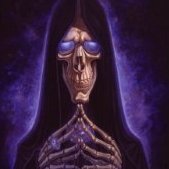Leaderboard
Popular Content
Showing content with the highest reputation on 02/28/22 in all areas
-
I'm opening this topic to summarise the technical changes that have been made to DR's renderer and get some feedback from my fellow coders. I'd love to get a peer review on the code changes, but going through that by looking at a pull request of that renderer branch would be a terrible experience, I assume, so instead I'd like to give an overview over what is done differently now. General things to know about DR's renderer DarkRadiant needs to support three different render views or modes: orthographic view, editor preview (fullbright) and lighting preview. Each of them has very different needs, but the lit preview is the most complex one, since it ideally should resemble what the TDM engine is producing. Apart from the obvious things like brush faces and model geometry, it needs to support drawing editor-specific things like path connection lines, light volumes, manipulators (like the rotation widget) or patch vertices. Nodes can be selected, which makes them appear highlighted: they display a red overlay and a white outline in the camera preview, whereas the orthoview shows selected item using a thicker red dashed line to outline selected items. DarkRadiant cannot specialise its renderer on displaying triangles only. Path lines for instance are using GL_LINE_STRIPs, Single brush faces (windings) are using GL_POLYGON for their outline (triangulation of brush faces in the ortho view or the camera (when selected) introduce a lot of visual noise, we just want the outline), patches want to have their control mesh rendered using GL_QUADS. Model surfaces (like .ASE and .LWO models) on the other hand are using GL_TRIANGLES all the way. Almost every object in DarkRadiant is mutable and can change its appearance as authors are manipulating the scene. CPU-intensive optimisations like generating visportal areas is not a likely option for DR, the scene can fundamentally change between operations. The Renderer before the changes DR's rendering used to work like this: all the visible scene nodes (brushes, patches, entities, models, etc.) were collected. They have been visited and were asked to forward any Renderable object they'd like to display to a provided RenderableCollector. The collector class (as part of the frontend render pass) sorted these renderables into their shaders (materials). So at the end of the front end pass, every shader held a list of objects it needed to display. The back end renderer sorted all the material stages by priority and asked each of them to render the objects that have been collected, by calling their OpenGLRenderable::render() method. After all objects rendered their stuff, the shader objects were emptied for the next frame. Culling of invisible objects has been happening by sorting objects into an Octree (which is a good choice for ortho view culling), some culling has been done in the render methods themselves (both frontend and backend calls). The problems at hand Doing the same work over and over again: it's rare that all the objects in the scene change at once. Usually prefabs are moved around, faces are textured, brushes are clipped. When flying through a map using the camera view, or by shifting the ortho view around, the scene objects are unchanged for quite a number of frames. Separation of concerns: every renderable object in the scene has been implementing its own render() method that invoked the corresponding openGL calls. There were legacy-style glBegin/glEnd rendering (used for path nodes), glDrawElements, glCallList, including state changes like enabling arrays, setting up blend modes or colours. These are render calls that should rather be performed by the back end renderer, and should not be the responsibility of, let's say, a BrushNode. Draw Calls: Since every object has been submitting its own geometry, there has been no way to group the calls. A moderately sized map features more than 50k brush faces, and about half as many patch surfaces. Rendering the whole map can easily add up to about 100k draw calls, with each draw call submitting 4 vertices (using GL_POLYGON). Inconsistent Vertex Data: since each object was doing the rendering on its own, it has been free to choose what format to save its data in. Some stored just the vertex' 3D coordinate, some had been adding colour information, some were using full featured vertices including normal and tangents. State Changes: since every object was handled individually, the openGL state could change back and forth in between a few brush windings. The entity can be influencing the shader passes by altering e.g. the texture matrix, so each renderable of the same material triggered a re-evaluation of the material stage, leading to a massive amount of openGL state changes. Then again, a lot of brushes and patches are worldspawn, which never does anything like this, but optimisation was not possible since the backend knew nothing about that. Lighting mode rendering: Lighting mode had a hard time figuring out which object was actually hit by a single light entity. Also, the object-to-entity relationship was tough to handle by the back end. Seeing how idTech4 or the TDM engine is handling things, DR has been doing it reversed. Lighting mode rendering has been part of the "solid render" mode, which caused quite a few if/else branches in the back end render methods. Lighting mode and fullbright mode are fundamentally different, yet they're using the same frontend and backend methods. The Goals openGL calls moved to the backend: no (frontend) scene object should be bothered with how the object is going to be rendered. Everything in terms of openGL is handled by the back end. Reduced amount of draw calls: so many objects are using the same render setup, they're using the same material, are child of the same parent entity, are even in almost the same 3D location. Windings need to be grouped and submitted in a single draw call wherever possible. Same goes for other geometry. Vertex Data stored in a central memory chunk: provide an infrastructure to store all the objects in a single chunk of memory. This will enable us to transition to store all the render data in one or two large VBOs. Support Object Changes: if everything should be stored in a continuous memory block, how do we go about changing, adding and removing vertex data? Changes to geometry (and also material changes like when texturing brushes) is a common use-case and it must happen fast. Support Oriented Model Surfaces: many map objects are influenced by their parent node's orientation, like a torch model surface that is rotated by the "rotation" spawnarg of its parent entity. A map can feature a lot of instances of the same model, the renderer needs to support that use-case. On the other hand, brush windings and patches are never oriented, they are always using world coordinates. Unified vertex data format: everything that is submitted as renderable geometry to the back end must define its vertex data in the same format. The natural choice would be the ArbitraryMeshVertex type that has been around for a while. All in all, get closer to what the TDM engine is doing: by doing all of the above, we put ourselves in the position to port more engine render features over to DR, maybe even add a shadow implementation at some point.2 points
-
I would not complain about NATO, if it really were an alliance of sovereign countries, but in reality it is not like that, with the US in absolute control, it has only caused us problems and several wars that had nothing to do with us, far from providing stability. While the US does not stop sticking its nose into matters that do not concern it and does not even bother to understand, it is an elephant in a china shop and we the subordinates who have to clean up afterward and pay for the damage. It is terrible what Russia is doing invading Ukraine and the whole world is rightly outraged by this. But how many countries has the US invaded, to impart democracy and incidentally, for oil? (1) Are we just as outraged by the refugees from Syria and other African countries fleeing terrorism and bombardments with our weapons as we are now by the Ukrainian refugees? There is a lot of hypocrisy on this matter, there is no black and white, more than those who have drowned in the Mediterranean for years, bled to death on barbed wire fences or die of disgust in concentration camps on the Turkish border. (1) 1. Grenada (1983-1984) 2. Bolivia (1986) 3. Virgin Islands (1989) 4. Liberia (1990; 1997; 2003) 5. Saudi Arabia (1990-1991) 6. Kuwait (1991) 7. Somalia (1992-1994; 2006) 8. Bosnia (1993-) 9. Zaire/Congo (1996-1997) 10. Albania (1997) 11. Sudan (1998) 12. Afghanistan (1998; 2001-) 13. Yemen (2000; 2002-) 14. Macedonia (2001) 15. Colombia (2002-) 16 Pakistan (2005-) 17. Syria (2008; 2011-) 18. Uganda (2011) 19. Mali (2013) 20. Niger (2013) 21. Yugoslavia (1919; 1946; 1992-1994; 1999) 22. Iraq (1958; 1963; 1990-1991; 1990-2003; 1998; 2003-2011) 23. Angola (1976-1992)2 points
-
No, no, that's not what I meant. You really do not have to watch that movie.1 point
-
It's the way they are internally stored to reduce draw calls, but they are indeed similar. I implemented the IWindingRenderer first, since that was the most painful spot, and I tailored it exactly for that purpose. The CompactWindingVertexBuffer template is specialised to the needs of fixed-size Windings, and the buffer is designed to support fast insertions, updates and (deferred) deletions. I guess it's not very useful for the other Geometry types, but I admit that I didn't even try to merge the two use cases. I tackled one field after the other, it's possible that the CompactWindingVertexBuffer can now be replaced to use some of the pieces I implemented for the lit render mode - there is another ContinuousBuffer<> template that might be suitable by the IWindingRenderer, for example. It's very well possible that the optimisation I made for brush windings was premature and that parts of it can be handled by the less specialised structures without sacrificing much performance. The model object is not involved in any rendering anymore, it just creates and registers the IRenderableSurface object. The SurfaceRenderer is then copying the model vertices in the large GeometryStore - memory duplication again (the model node needs to keep the data around for model scaling). The size of the memory doesn't seem to be a problem, the data is static and is not updated very often (except when scaling, but the number of vertices and indices stays the same). The thing that makes surfaces special is their orientation, they have to be rendered one after the other, separated by glMultMatrix() calls. Speaking about writing the memory allocator: I was quite reluctant to write all that memory management code, but I saw no escape routes for me. It must have been the billionth time this has been done on this planet. Definitely not claiming that I did a good job on any of those, but at least it doesn't appear in the profiler traces.1 point
-
Plunder Panic 100% off on Steam https://slickdeals.net/f/15642841-plunder-panic-steam-digital-download-free https://store.steampowered.com/app/1455900/Plunder_Panic/1 point
-
Overall these changes sound excellent. You have correctly (as far as I can tell) identified the major issues with the DR renderer and proposed sensible solutions that should improve performance considerably and leave room for future optimisations. In particular, trying to place as much as possible in a big chunk of contiguous RAM is exactly the sort of thing that GPUs should handle well. Some general, high-level comments (since I probably haven't even fully understood the whole design yet, much less looked at the code). Wireframe versus 3D I always thought it was dumb that we had different methods to handle these: at most it should have been an enum/bool parameter. So it's good to see that you're getting rid of this distinction. Unlit versus lit renders As you correctly point out, these are different, particularly in terms of light intersections and entity-based render parameters (neither of which need to be handled in the unlit renderer), so it makes sense to separate them and not have a load of if/then statements in backend render methods which just slow things down. However, if I'm understanding correctly, in the new implementation almost every aspect will be separate, including the backend data storage. Surely a lot of this is going to be the same in both cases — if a brush needs to submit a bunch of quads defined by their vertices, this operation would be the same regardless of whatever light intersection or GLSL setup calculations were performed first? Even if lighting mode needs extra operations to handle lighting-specific tasks, couldn't the actual low-level vertex sorting and submission code be shared? If double RAM buffers and glFenceSync improves performance in lit mode, wouldn't unlit mode also benefit from the same strategy? I guess another way of looking at is is: could "unlit mode" actually be a form of lit mode where lighting intersections were skipped, submitted lights were ignored, and the shader was changed to return full RGB values for every fragment? Or does this introduce performance problems of its own? Non-const shaders I've never liked the fact that Shaders are global (non-threadsafe) modifiable state — it seems to me that a Shader should know how to render things but should not in itself track what is being rendered. Your changes did not introduce this problem and they don't make it any worse, so it's not a criticism of your design at all, but I wonder if there would be scope to move towards a setup whereby the Shaders themselves were const, and all of the state associating shaders with their rendered objects was held locally to the render operation (or maybe the window/view)? This might enable features like a scrollable grid of model previews in the Model Selector, which I've seen used very effectively in other editors. But perhaps that is a problem for the future rather than today. Winding/Geometry/Surface Nothing wrong with the backend having more knowledge about what is being rendered if it helps optimisation, but I'm a little unclear on the precise division of responsibilities between these various geometry types. A Winding is an arbitrary convex polygon which can be rendered with either GL_LINES or GL_POLYGON depending on whether this is a 2D or 3D view (I think), and most of these polygons are expected to be quads. But Geometry can also contain quads, and is used by patches which also need to switch between wireframe and solid rendering, so I guess I'm not clear on where the boundary lies between a Winding and Geometry. Surface, on the other hand, I think is used for models, but in this case the backend just delegates to the Model object for rendering, rather than collating the triangles itself? Is this because models can have a large variation in the number of vertices, and trying to allocate "slots" for them in a big buffer would be more trouble than it's worth? I've never had to write a memory allocator myself so I can can certainly understand the problems that might arise with fragmentation etc, but I wonder if these same problems won't rear their heads even with relatively simple Windings. Render light by light Perfect. This is exactly what we need to be able to implement things like shadows, fog lights etc (if/when anybody wishes to work on this), so this is definitely a step in the right direction. Overall, these seem like major improvements and the initial performance figures you quote are considerable, so I look forward to checking things out when it's ready.1 point
-
If it adds more time to development it's not worth it IMO. Time could be better spent elsewhere, like in the amazing work with 2.10 and textures/images/etc that I've been seeing in recent missions.1 point







